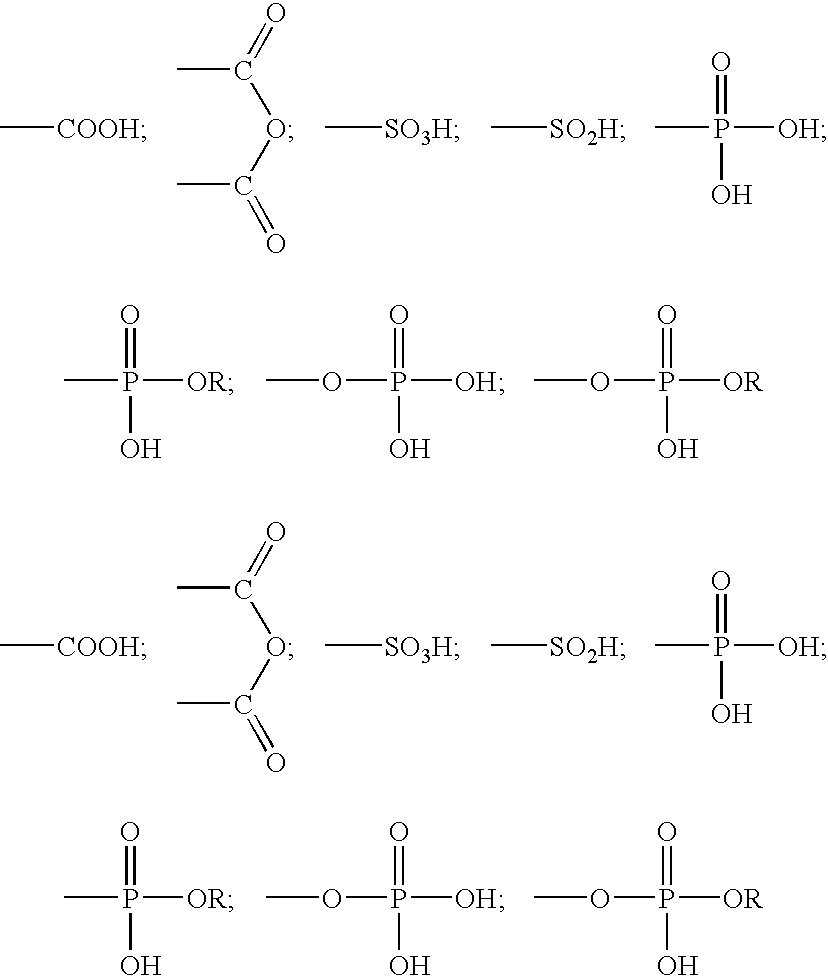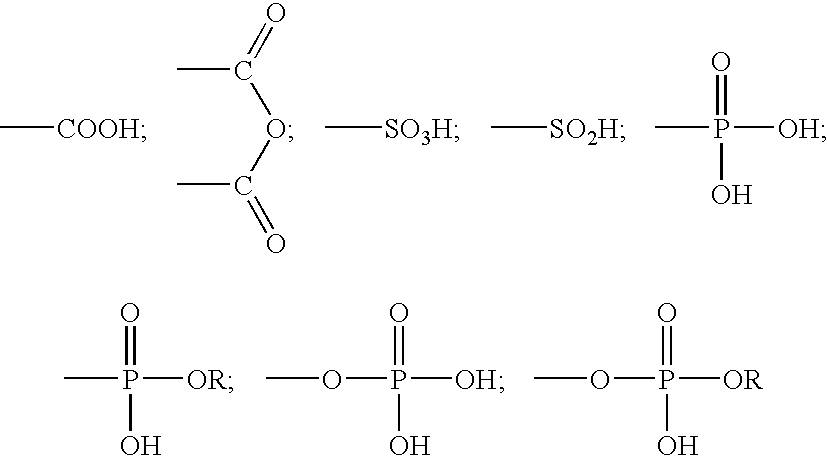Self-adhesive dental cement
a self-adhesive, dental cement technology, applied in the field of dental cements, can solve the problems of difficult combination of essential ingredients, complex and technique sensitivity, and hinder the popularity of resin cements, and achieve the effect of enhancing the initiating efficiency of benzoyl thiourea/cumene hydroperoxide and being convenient to control
- Summary
- Abstract
- Description
- Claims
- Application Information
AI Technical Summary
Benefits of technology
Problems solved by technology
Method used
Image
Examples
example 1
Base Paste
[0035]10.93% by weight of Bis-GMA,
12.75% by weight of EBPADMA,
10.93% by weight of TEGDMA,
1.82% by weight of TMPTMA,
0.02% by weight of BHT,
0.38% by weight of BTU,
0.11% by weight of CQ,
0.30% by weight of EDAB,
0.76% by weight of L-TPO,
61.23% by weight of silianated barium boron fluoro aluminosilicate glass,
0.77% by weight of Cab-O—Sil TS 720
Catalyst Paste:
[0036]7.30% by weight of Bis-GMA,
8.30% by weight of EBPADMA,
8.10% by weight of TEGDMA,
1.82% by weight of TMPTMA,
11.00% by weight of PENTA,
0.02% by weight of BHT,
1.46% by weight of CHP,
61.23% by weight of silianated barium boron fluoro aluminosilicate glass,
0.77% by weight of Cab-O—Sil TS 720
[0037]When the base paste was mixed with the catalyst paste (1:1 by volume), the shear bond strength of the cement in self-cure mode was 3.6 MPa on dentin without prior chemical treatment of the tooth. The baseline set time of the mixed cement was 3 minutes and 45 seconds. After aging at 45° C. for 12 weeks, the set time was 4 minutes and...
example 2
Base Paste
[0038]11.19% by weight of Bis-GMA,
13.06% by weight of EBPADMA,
11.19% by weight of TEGDMA,
1.87% by weight of TMPTMA,
0.02% by weight of BHT,
0.38% by weight of BTU,
0.08% by weight of CQ,
0.15% by weight of DMABN,
0.08% by weight of L-TPO,
61.18% by weight of strontium calcium aluminosilicate glass,
0.80% by weight of Cab-O—Sil TS 720
[0039]Catalyst paste: same as the one illustrated in Example 1.
[0040]When the base paste was mixed with the catalyst paste (1:1 by volume), the shear bond strength of the cement in self-cure mode was 3.7 MPa on dentin without prior chemical treatment of the tooth. The baseline set time of the mixed cement was 5 minutes. After aging at 45° C. for 9 weeks, the set time was 5 minutes and 50 seconds, no significant change from the baseline. The diametral tensile strength of the cement in self-cure mode was 34.7 MPa.
example 3
Base Paste
[0041]8.72% by weight of Bis-GMA,
10.18% by weight of EBPADMA,
8.72% by weight of TEGDMA,
1.46% by weight of TMPTMA,
0.01% by weight of BHT,
0.65% by weight of BTU,
0.07% by weight of CQ,
0.08% by weight of DMABN,
0.10% by weight of L-TPO,
67.38% by weight of strontium calcium aluminosilicate glass,
0.88% by weight of Cab-O—Sil TS 720
1.75% by weight of calcium hydroxide
Catalyst Paste:
[0042]7.97% by weight of Bis-GMA,
9.30% by weight of EBPADMA,
7.98% by weight of TEGDMA,
1.33% by weight of TMPTMA,
8.55% by weight of PENTA,
0.01% by weight of BHT,
0.86% by weight of CHP,
63.2% by weight of silianated barium boron fluoro aluminosilicate glass,
0.80% by weight of Cab-O—Sil TS 720
[0043]When the base paste was mixed with the catalyst paste (1:1 by volume), the work time was 2 minutes and 45 seconds and set time of the mixed cement was 4 minutes. The shear bond strength of the cement in self-cure mode was 5.0 MPa on dentin and 11.2 MPa on enamel without prior chemical treatment of the tooth. The ...
PUM
| Property | Measurement | Unit |
|---|---|---|
| Percent by mass | aaaaa | aaaaa |
| Percent by mass | aaaaa | aaaaa |
| Percent by mass | aaaaa | aaaaa |
Abstract
Description
Claims
Application Information
 Login to View More
Login to View More - R&D
- Intellectual Property
- Life Sciences
- Materials
- Tech Scout
- Unparalleled Data Quality
- Higher Quality Content
- 60% Fewer Hallucinations
Browse by: Latest US Patents, China's latest patents, Technical Efficacy Thesaurus, Application Domain, Technology Topic, Popular Technical Reports.
© 2025 PatSnap. All rights reserved.Legal|Privacy policy|Modern Slavery Act Transparency Statement|Sitemap|About US| Contact US: help@patsnap.com


